“], “filter”: { “nextExceptions”: “img, blockquote, div”, “nextContainsExceptions”: “img, blockquote, a.btn, a.o-button”} }”>
Heading out the door? Study this textual content on the model new Exterior+ app on the market now on iOS models for members!
>”,”determine”:”in-content-cta”,”sort”:”hyperlink”}}”>Acquire the app.
When the photo voltaic rose on the morning of October 5, Fay Manners and Michelle Dvorak sat perched on a tiny rock ledge at 6,400 meters, extreme on the flanks of the 6,995-meter (22,949ft) Himalayan peak Chaukhamba III. The pair had been stranded on the ledge for 48 hours and never utilizing a tent, meals, or water. They’ve been exhausted and freezing.
Two days prior, Dvorak and Manners had been making an attempt the first ascent of the Indian peak when falling rocks sliced a rope and despatched their haul bag full of most of their survival objects and technical gear plummeting to the valley floor. The accident left them stranded with out an inReach machine, tent, vary and gasoline, and most of their down apparel.
As the two rested, a search helicopter from the Indian Air Drive appeared overhead—it circled the mountain quite a few cases, nevertheless flew off with out recognizing them. It was the second fly-by in as many days.
“We’ve got been shattered,” Manners instructed Exterior. “At this degree we haven’t eaten for two days. We’re severely dehydrated. We’re freezing. We’ve been on the wall seven days.”
Manners was near hypothermic. With the snowstorm worsening, she did not think about the two would possibly survive one different night time time on the precarious perch. She envisioned two decisions for survival: Carry on the ledge a third night time time and hope that the helicopters would uncover them, or descend the wall after which navigate a technical, crevasse-filled icefall with just one set of crampons and ice axes. Every choices bought right here with deadly risks.
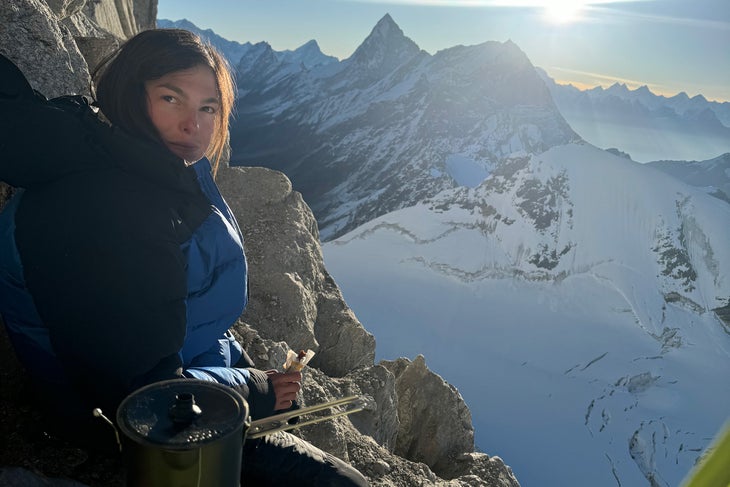
The Attempt of Chaukhamba III
Manners, 37, and Dvorak, 31, are every extraordinarily expert alpinists. Manners has established new routes from distant Pakistan to Greenland—the latter with Dvorak and late soloist Martin Feistl. Chaukhamba III, throughout the Garhwal Himalaya of India’s mountainous Uttarakhand state, was a turning into aim for the pair. Extreme and distant, with a dangling triangular southeast buttress that no person had ever tried, the peak equipped a lovely drawback.
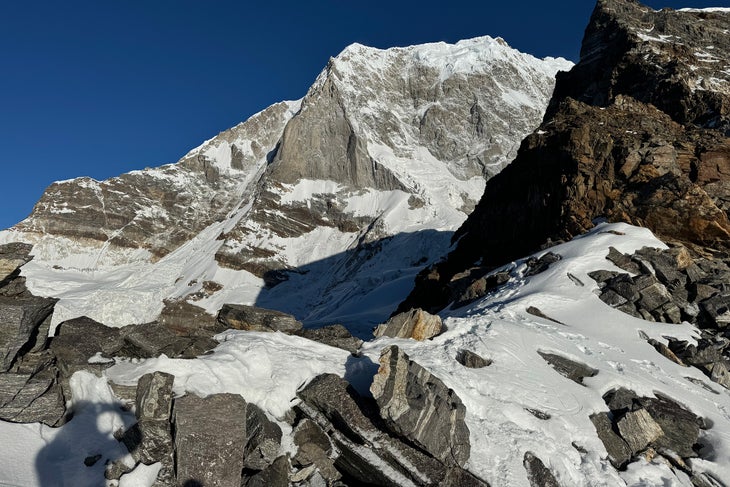
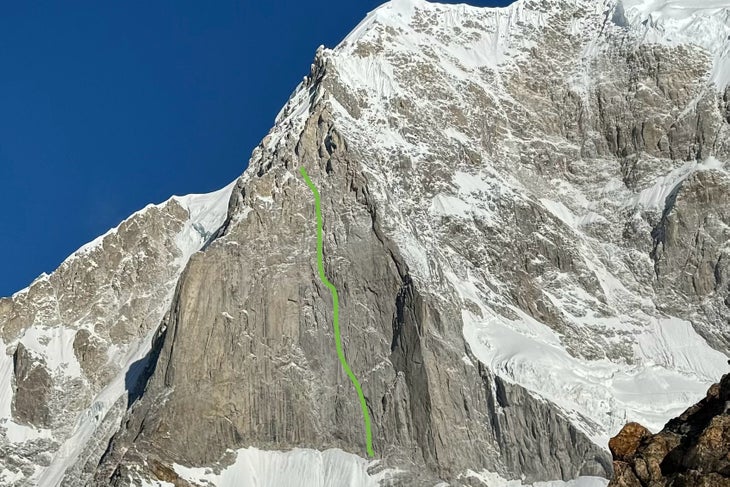
The two left Delhi for the mountain on September 15. After establishing a base camp, they spent September 24 to 26 planning their methodology all through a steep, winding line by a labyrinth of crevasses to realize the peak’s southeast buttress. “Snow bridges broke on us, now we have been occurring and up crevasses, having to ice climb with our axes and crampons—all sooner than we even reached the col,” Manners said. “By the purpose we discovered the best way to get to our route, we felt like we’d achieved one different route in itself.”
Manners and Dvorak left basecamp for good on September 27, reaching the buttress the following day. Over the following 5 days, they ascended the steep 600-meter granite face, discovering many pitches of onerous, consequential climbing as a lot as 5.12a. The women made common progress. The circumstances was dry and warmth, which allowed them to climb with bare fingers, however as well as elevated their publicity to rockfall at temperatures rose.
“We’d solely climb when it was warmth,” Dvorak said. “As shortly as a result of the shade hit, our fingers have been freezing, and it was unattainable to climb.” After dawn-to-dusk days alternating between muddy scrambling on lower-angle sections and onerous mountaineering on the steeper parts of the face, and prolonged, near-sleepless nights cramped on small ledges, the pair was nearing the very best of the buttress. Shortly, they may be a part of with the peak’s south ridge, the place lower angles guarded the summit.
At 1 p.m. on Thursday, October 3, Manners was throughout the lead, with Dvorak following behind. Every women carried a small amount of drugs in backpacks, nevertheless the vast majority of their gear—included the inReach, tent, vary, gasoline, moveable power banks, one pair of crampons and ice axes, down pants and headlamp, and completely different requirements—have been in a haul bag.
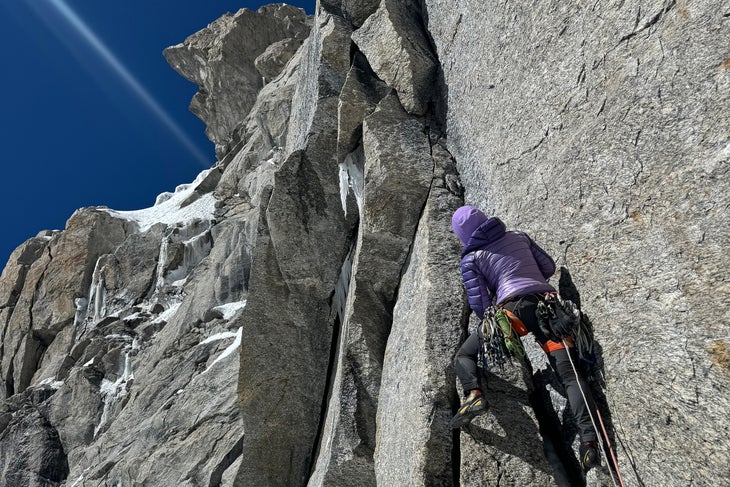
As Manners hauled the bag, the ropes turned caught. Dvorak, watching from beneath, climbed above the bag to try to free it. That’s when the cliff beneath her broke apart, slicing the rope holding their gear. “These rocks merely bought right here out from beneath me,” she said. “The following issue I knew, I appeared down, and the bag was gone.”
The shortage of the gear was catastrophic, and signaled an immediate end to their climb. At first, the women have been merely disillusioned that they wouldn’t be able to finish their route. Nonetheless after a second, they realized merely what variety of of their requirements had been contained within the haul bag. As if on command, darkish clouds rolled in, and heavy snow began to fall. The great and comfy local weather that had accompanied them for the ultimate 5 days was coming to an end. “The mood really modified,” Dvorak said. “We’ve got been an identical to, ‘Oh, shit. We’re not protected on this mountain anymore.’”
Three Days of Snow and Wind
Though Manners’s inReach was misplaced with the bag, Dvorak had an an identical machine, a ZOLEO. Not like a Garmin inReach, this machine doesn’t have its private show, and requires a paired smartphone to operate. Dvorak’s phone had merely ample price for her to hearth off a single SOS, nevertheless her phone died merely moments after the message was despatched. Manners and Dvorak knew their message was throughout the ether and their location had been marked for rescuers, nevertheless they’d no thought if any have been coming. So the women waited.
That that they had ample rope and tools to descend from the buttress, nevertheless as quickly as they did, they’d nonetheless must navigate the icy, steep, crevasse-filled descent off the col to their camp. Descending this half with just one pair of crampons was a high-risk alternative. “Given the extraordinarily superior, tough methodology, we knew it wasn’t attainable,” Manners said. “Even once we get down off the rock, how the hell are we going to operate on that terrain with out our gear?”
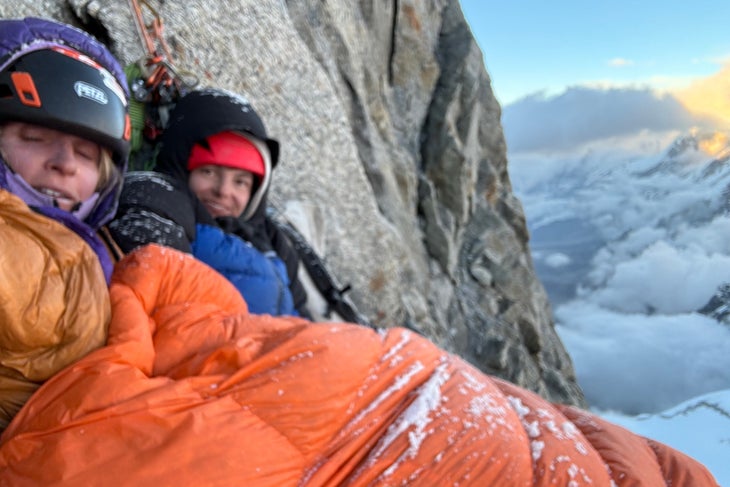
It made further sense to stay put and look ahead to a rescue. When rescue helicopters confirmed up late on that first day, it appeared like their alternative to stay was applicable. Nonetheless then the helicopters flew overhead with out stopping. This occurred as soon as extra the following day.
“That’s as soon as we started to have extended conversations about what we must always all the time do, about how rather a lot we must always all the time risk,” Manners said.
The duo had no meals or no water. Dvorak had her down parka and pants, nevertheless Manners’ chilly local weather gear had been throughout the haul bag. They’ve been sharing what they may, nevertheless Manners was certain she wouldn’t survive one different night time time on the ledge. “I was going to freeze,” she said.
On the third day, the women began rappelling down the buttress. They weren’t constructive how they’d navigate the tactic. They may break up up, with one explicit individual taking the sleeping bag and making an attempt to survive whereas the alternative used the crampons to descend to basecamp. Or, they may each placed on one crampon and check out the descent collectively. Every decisions required energy and stamina, and the women have been weakened by their carry on the ledge.
“We’d already waited two days up there. We’ve got been severely dehydrated, hungry, freezing,” Manners said. “Our our our bodies have been weak, and even sooner than we misplaced the haul bag the climbing had been pushing our limits.”
The selection ended up being moot. Whereas rappelling down the buttress late on Saturday, Manners and Dvorak seen a four-person group of climbers on the glacier. “We realized we wanted to catch these guys,” Dvorak said. “That is maybe our solely likelihood to get out of proper right here.”
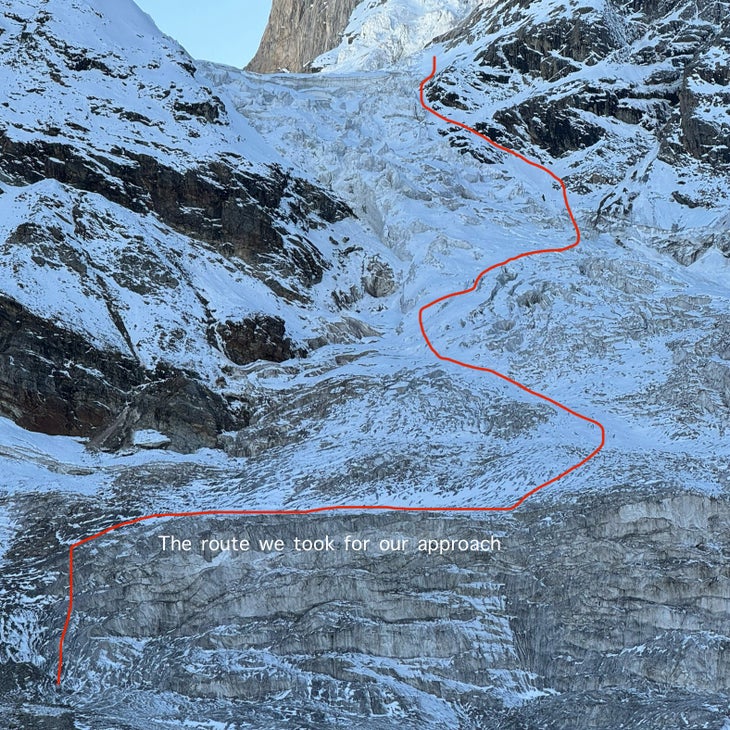
The 4 climbers have been from the elite Groupe Militaire de Haute Montagne, of Chamonix. On account of unhealthy local weather, they’d abandoned their very personal strive on the peak’s east pillar. That’s as soon as they heard phrase of the missing Manners and Dvorak.
Dvorak and Manners rappelled as fast as they may down the buttress, nevertheless neglected the French group. After a few minutes the squad appeared immediately beneath them, solely 100 or so toes above the glacier.
“It was a miracle,” Manners said. “Good timing. After we purchased to them, they’d been attempting to get to us as properly. We’ve got been nervous that presumably they didn’t even know now we have been missing, and have been merely coming to try their route, so my coronary coronary heart was overfull as soon as we discovered they’ve been there for us.”
With gear and assist from the French group, Manners and Dvorak have been ready to descend to the French superior base camp at spherical 5,180 meters. They’ve been airlifted out by helicopter the following day.
The two said they obtained a warmth welcome from the Indian Mountaineering Federation (IMF), which organized the rescue. “There’s no, ‘Proper right here’s a big bill for the rescue, you owe us,’ mentality,” said Manners. “The message was, ‘We’re so blissful we’d get to you, and we want you to come back again once more and we want you to do this mountain as soon as extra.”
A Media Whirlwind
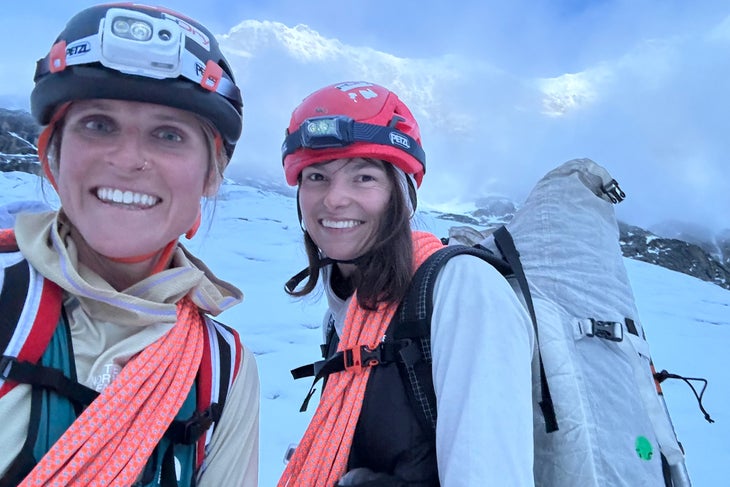
Info of the rescue unfold throughout the globe. The women have been helicoptered out on the morning of Sunday, October 6, and inside 48 hours, safety of their ordeal appeared on fairly just a few retailers, from the BBC to Good Morning America. It was further publicity than each girl had obtained of their careers. Nonetheless every instructed Exterior they’d blended feelings regarding the consideration.
“Truly every Michelle and I actually really feel we put in a grand effort proper right here,” Manners said. “Nonetheless this could be a mountain we didn’t summit. The mountains now now we have summited, the successes we’ve had, they haven’t obtained nearly as rather a lot publicity.”
Manners said that the pair search to encourage women to get into the mountains—a goal which will very properly be jeopardized by the tales. “I don’t want this story to position people off from the sport,” she said.
Manners and Dvorak instructed Exterior they’d ceaselessly replayed the ordeal, asking themselves if they may have achieved points differently. A steeper, cleaner route up the face may have lowered rockfall. Manners may need carried her Garmin in a pocket instead of throughout the haul bag.
Nonetheless they admitted that it’s highly effective to nitpick. “It’s easy to say I would have picked a better route,” Manners said. “Nonetheless we’re the first people that tried to make our method up this buttress. So it’s onerous to say what a better route would have been.”
